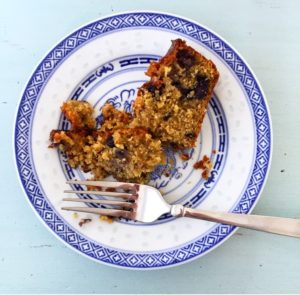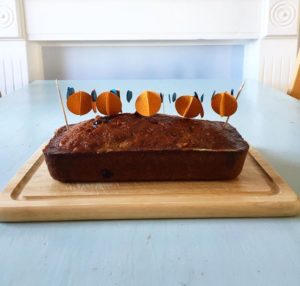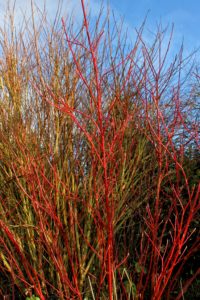I have become mildly obsessed with TED Talks and have to ration myself to only starting one when I know I have time to listen and watch many. Like others might binge a Netflix series, I can do the same for these presentations. And it’s not just about the interesting subjects, it also has to do with a strange fascination I have with confident speakers. As much as what they say, I am drawn to the gesticulations, expression, rhythm of speaking and the movement that goes unplanned with their words. It is something we all do, to a greater or lesser extent and I find it an interesting thing that when (in theory) words should be enough to convey what we are saying, our bodies give these impromptu extras.
Recently, when watching a news presenter giving a report while wearing a face covering, MOTH made a passing comment about the gesticulations looking odd without seeing the mouth moving too. My brain being what it is, I now can’t stop thinking about why and how our brains deliver these non-verbal expressions without our conscious instruction to do them. Have we always done it? Does everyone gesticulate? Do all cultures? What is the impact of not doing so? And so on. Perhaps there is a TED Talk about it. (I’ve just looked. There isn’t. Could someone do one please?) A moment to say, please, please wear a mask. No, none of us like it but we do things every day that are annoying, uncomfortable or we don’t like, so let’s all just crack on with this too, shall we.
Speaking of coverings (yes, exceedingly tenuous linking of thoughts – my mum will appreciate that) it is too blinking hot and I am longing to live in the lightest billowing cotton kaftan that will magically never actually touch my skin- does anyone have one I can borrow? I know I am most likely to be in the minority here, but I really don’t like this extreme heat. As someone who is cold ninety-nine percent of the time, you’d think I’d be happy when the sun was blazing. But it’s as if, when I finally get warm, my body doesn’t know how to cope with it. I literally swell up and ache and get very, very grumpy. (MOTH will attest to this with ‘help, get me out of here’ subtle eye movements.) I am longing for days of rain and snuggling up in a jumper. I am writing this in my study with the curtains half-drawn and a fan on while I am sure most of you are probably sunbathing and maybe even at the beach. The fan, by the way, is precariously close to the hanging tendrils of a flowering spider plant and I am aware that there may be a shower of little white petals blown my way at some point. Still, I usually have bits of garden in my hair or down the back of my t-shirt so it won’t make too much difference.
Speaking of the garden – it is wilting and crisping and we are hoping our main crop potatoes aren’t going to be pulled up pre-baked. We lifted our 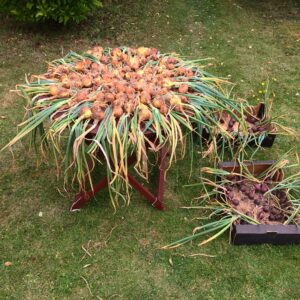 onions recently and are still feeling abundantly smug about the haul. Quite possibly over one-hundred; and ten garlic bulbs as well. As ever we are running out of ways to eat excessive amounts of courgette, it is currently being added to pretty much every meal – and still they come.
onions recently and are still feeling abundantly smug about the haul. Quite possibly over one-hundred; and ten garlic bulbs as well. As ever we are running out of ways to eat excessive amounts of courgette, it is currently being added to pretty much every meal – and still they come.
Every year I say I am never going to make jam again. This usually happens when I have been cleaning and sterilising jars, prepping huge amounts of fruit and standing over a boiling pan of bubbling fruit and sugar – all in the hottest months (merely adding to the heat I already can’t deal with – yes, I’m still grumping). Well, I have been making jam. And there will probably be more to come. The first large batch has been greenage – it seems we have a bumper crop for the first time. Most years we barely get any as, just at the point of nearly ripe, every single one gets utterly devoured by wasps. So this year, I took my cue from the stripy sugar-loving beasts and at the first signs of them boring into the fruit, I picked a basket load and finished ripening them in a paper bag. Then realised I would have to do something with them all, now that they were picked. Next up; the plums. And damsons. And apples. And blackberries. Oh dear.
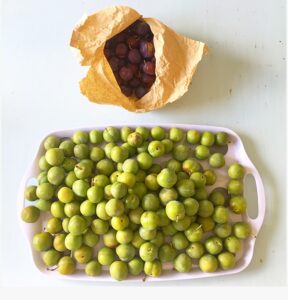
It is amazing how much time it takes dealing with a mass of homegrown produce to make sure it is kept well enough to last into winter and beyond. My grandparents had the most amazing cellar which was full of jars upon jars of bottled fruit (as well as Grandad’s home-made wine – of varying successes) and I can only imagine how much time Grandma must have spent getting everything picked, prepped and stored because I don’t remember there ever being a time when there weren’t fruits to choose from, whatever the season. The exciting feeling and glorious scents of going down into the cellar I don’t think will ever leave me. It was the place where the surplus cake tins were kept, the extra cups, jars, large sieves and all manner of not-quite every day items – including (we found when sorting their estate) a teacup, with a special lip to guard the drinker’s moustache from getting wet. (Here is a
terrible picture.)
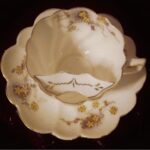
Back to the courgettes, because, as any vegetable gardener will attest – they are too numerous to ignore. One approach to use a good amount while being able to hide the quantity from those who are not so keen, is to make courgette potato cakes. Make your mashed potato as usual and let cool. Grate as many courgettes as you think you can get away with and wring them out in a tea towel to get rid of as much moisture as possible. Add the courgette to the potato and season: salt, pepper and chives works well, then squish down into a pastry cutter to create the ‘cake.’ Alternatively, make the mixture into balls and roll in flour. Both of these freeze brilliantly and cook from frozen and you can totally deceive doubters by not telling them they contain large quantities of courgette – especially if they are served with a runny-yolk poached egg on top.
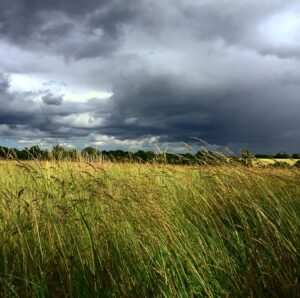
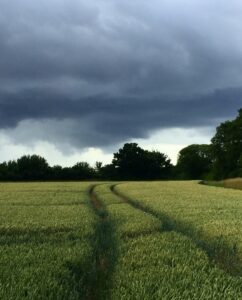 We were promised thunderstorms this week; they did not come – which I was annoyed about. We have had some rain, intermittent sun and
We were promised thunderstorms this week; they did not come – which I was annoyed about. We have had some rain, intermittent sun and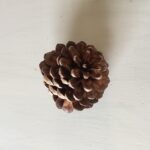 As I picked it up to bring home I realised I experienced the same feeling as I have done in the past when buying a new item of clothing or the such. I read a book recently which talked about how we get used to new things so quickly that they lose their ‘spark’ in very little time which is what compels us to then buy again and again and again. It’s why some very rich people have multiple cars of huge value and still never feel satisfied. They are merely looking for the next hit of new. That being the case, perhaps a pine cone really can have the same excitement-producing reception in the brain that a new pair of boots can.
As I picked it up to bring home I realised I experienced the same feeling as I have done in the past when buying a new item of clothing or the such. I read a book recently which talked about how we get used to new things so quickly that they lose their ‘spark’ in very little time which is what compels us to then buy again and again and again. It’s why some very rich people have multiple cars of huge value and still never feel satisfied. They are merely looking for the next hit of new. That being the case, perhaps a pine cone really can have the same excitement-producing reception in the brain that a new pair of boots can.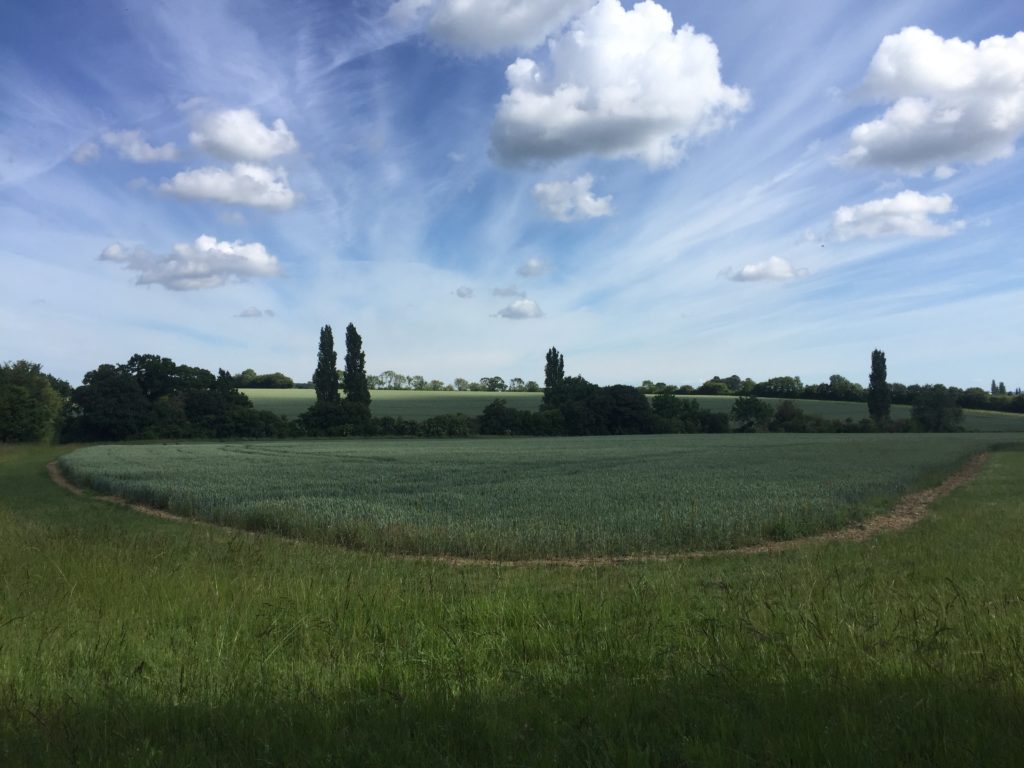
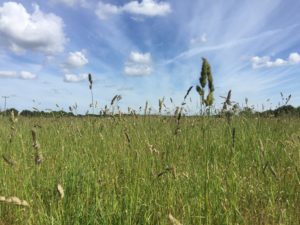 and the beautiful feathery fronds jigged in the breeze with their soft green and purple hues. Beautiful. But, as with as many places there is talk of it being built on which saddens me greatly. I can see brambles beginning to flower in the hedgerows, bringing promises of delicious fruits to come. I will be out picking and eating later in the year.
and the beautiful feathery fronds jigged in the breeze with their soft green and purple hues. Beautiful. But, as with as many places there is talk of it being built on which saddens me greatly. I can see brambles beginning to flower in the hedgerows, bringing promises of delicious fruits to come. I will be out picking and eating later in the year.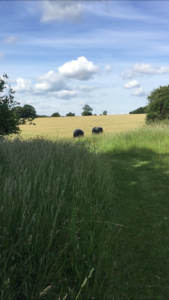 Against all the blue, green and yellow of this early summer day, large shining black plastic greeted me next – the covering for bales of straw. My best friend and I have long loved the sight of bales in fields, particularly as we feel they always seem as if they are grazing. Many a time we have sent each other pictures of such with the caption: grazing bales. I may have tweeted a video at her this time.
Against all the blue, green and yellow of this early summer day, large shining black plastic greeted me next – the covering for bales of straw. My best friend and I have long loved the sight of bales in fields, particularly as we feel they always seem as if they are grazing. Many a time we have sent each other pictures of such with the caption: grazing bales. I may have tweeted a video at her this time.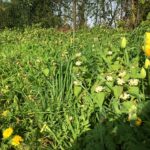 Now that the bulk of flowering is over I have begun to reduce the area by at least half – and found a lovely surprise under it all – a patch of wild garlic which I had no idea was there. Next to the fenced grass pile (which has been phenomenal at giving us mulch at this time when garden centres have been closed) there peered up at me some rather light-deprived wild garlic; rather sorry leaves but lovely delicate white flowers. I am hoping it will recover now that it is not weighed down by comfrey and I might try transplanting some to a place a little easier to get to and keep clear.
Now that the bulk of flowering is over I have begun to reduce the area by at least half – and found a lovely surprise under it all – a patch of wild garlic which I had no idea was there. Next to the fenced grass pile (which has been phenomenal at giving us mulch at this time when garden centres have been closed) there peered up at me some rather light-deprived wild garlic; rather sorry leaves but lovely delicate white flowers. I am hoping it will recover now that it is not weighed down by comfrey and I might try transplanting some to a place a little easier to get to and keep clear.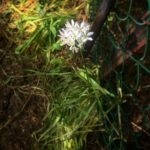
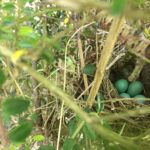 Naturally, I immediately backed off and I am happy to report that I have seen an adult on the nest since, so I am no longer worried about having disturbed it.
Naturally, I immediately backed off and I am happy to report that I have seen an adult on the nest since, so I am no longer worried about having disturbed it.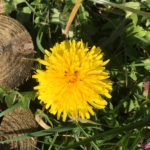

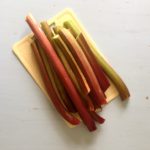 triumphant red arms, defiantly waving enormous leaves at me. And so, as I write this, I have a huge amount of rhubarb chutney simmering away as well as three crumbles ready for the freezer. It is the spider plant of the garden – un-killable!
triumphant red arms, defiantly waving enormous leaves at me. And so, as I write this, I have a huge amount of rhubarb chutney simmering away as well as three crumbles ready for the freezer. It is the spider plant of the garden – un-killable!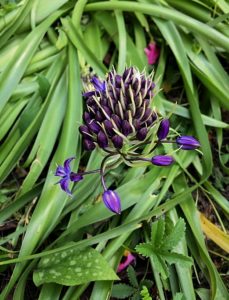 The best thing though, was that they told me that they called them angry panthers, and to this day, that is what I call them too. I know roughly where it is located but the ground covering mat of ajuga, pulmonaria and creeping cinquefoil, has hindered any precise pinpointing – hence the search. So far, the angry panther remains elusive, but I live in hope.
The best thing though, was that they told me that they called them angry panthers, and to this day, that is what I call them too. I know roughly where it is located but the ground covering mat of ajuga, pulmonaria and creeping cinquefoil, has hindered any precise pinpointing – hence the search. So far, the angry panther remains elusive, but I live in hope.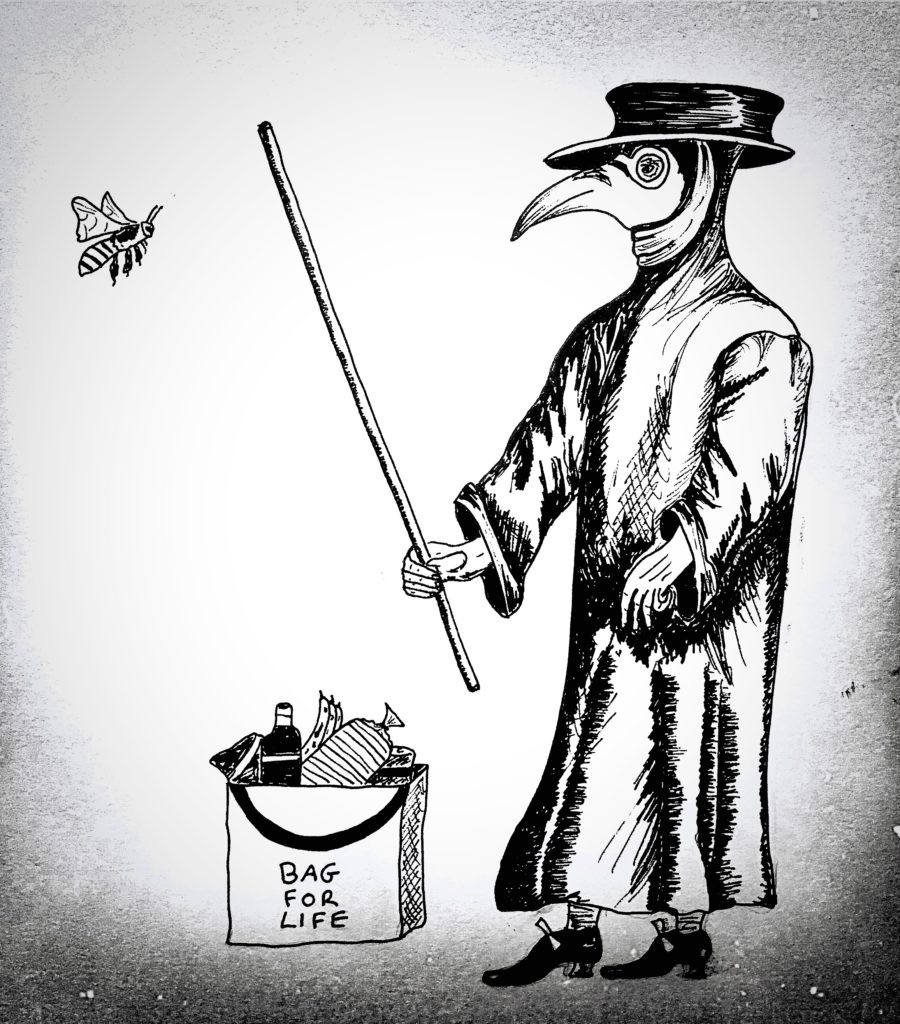
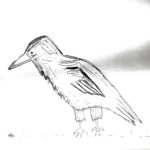 This was in fact what started the plague doctor discussion as I have always been reminded of such by rooks, because of their lighter coloured beaks. They remind me of the masks worn by the doctors treating sick people during the bubonic plague. These masks included a long hollow beak stuffed with highly scented herbs with the thought that this would purify the air. The rest of their costume was often made up of a long heavy coat and gloves and a stick to keep the sick at bay. There was mention that many or all of these things could be useful when doing the weekly shop at the moment.
This was in fact what started the plague doctor discussion as I have always been reminded of such by rooks, because of their lighter coloured beaks. They remind me of the masks worn by the doctors treating sick people during the bubonic plague. These masks included a long hollow beak stuffed with highly scented herbs with the thought that this would purify the air. The rest of their costume was often made up of a long heavy coat and gloves and a stick to keep the sick at bay. There was mention that many or all of these things could be useful when doing the weekly shop at the moment.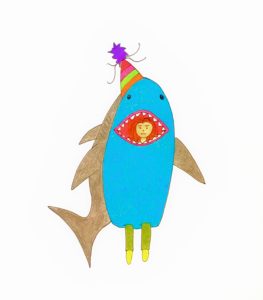 comfortable and there is always the possibility that I could, if the spirit took me, spontaneously launch into exercise (pause whist taking a moment to haul self, up off the floor from laughter at this idea.)
comfortable and there is always the possibility that I could, if the spirit took me, spontaneously launch into exercise (pause whist taking a moment to haul self, up off the floor from laughter at this idea.)